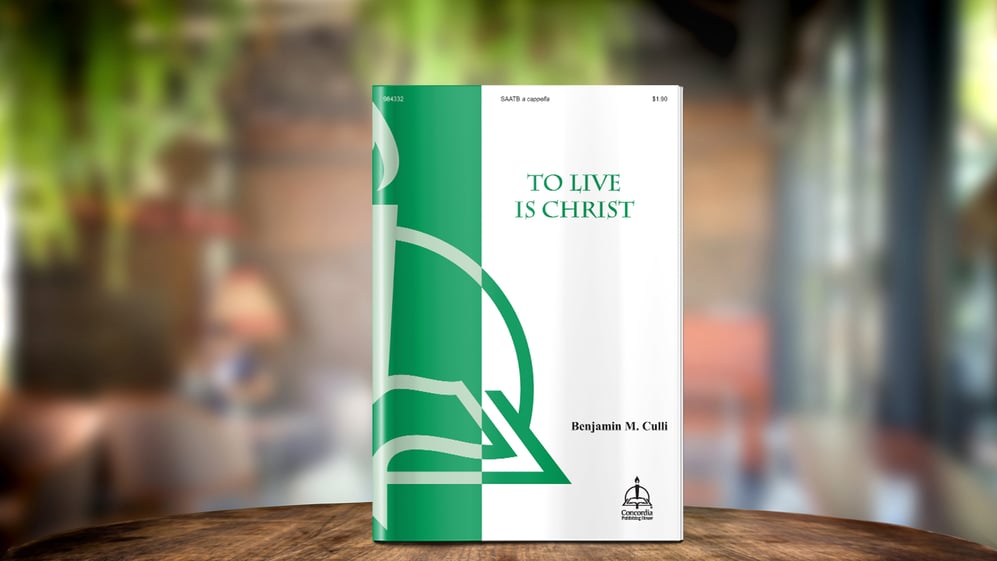Benjamin M. Culli’s exquisite SAATB a cappella anthem uses a text by Lisa M. Clark. Inspired by Philippians 1:21, “For to me to live is Christ, and to die is gain,” this piece features a soaring tune that is supported by close, rich harmonies. Listen to the piece below, and order the score at the end of the post.
Scriptural Inspiration
Let’s begin by looking at the surrounding Scripture passage this anthem is based on, Philippians 1:18b–26.
Yes, and I will rejoice, 19 for I know that through your prayers and the help of the Spirit of Jesus Christ this will turn out for my deliverance, 20 as it is my eager expectation and hope that I will not be at all ashamed, but that with full courage now as always Christ will be honored in my body, whether by life or by death. 21 For to me to live is Christ, and to die is gain. 22 If I am to live in the flesh, that means fruitful labor for me. Yet which I shall choose I cannot tell. 23 I am hard pressed between the two. My desire is to depart and be with Christ, for that is far better. 24 But to remain in the flesh is more necessary on your account. 25 Convinced of this, I know that I will remain and continue with you all, for your progress and joy in the faith, 26 so that in me you may have ample cause to glory in Christ Jesus, because of my coming to you again.
In verse 21, Paul tells us that good things come to Christians in both life and death. In life, God uses us to accomplish His will. In death, we are freed from the worries of our earthly lives and are with God in eternal peace.
Is it natural for us to want to escape the suffering of this world. What Christian hasn’t thought about how much better it would be to live in heaven than here on earth? But we know God has put each of us here for a purpose—to tell others of His salvation in Jesus and to deliver His care to others through our service. Paul touches on this tension in verses 23 and 24 and writes that he chooses to endure through his earthly sufferings so God can use him according to His will.
Like Paul, we live in this tension. And like Paul, we continue on in our lives, knowing that God gives us the strength we need to endure the path He has set before us.
Textual Themes
Lisa Clark wrote a three-stanza poem for this piece:
To live is Christ, to die is gain.
In either, may the truth remain:
I am in Him! He is in me.
The Son of God has set me free.The Son of God has set me free,
This child born in humility.
For me He suffered, bled, and died.
Now in His love, I may abide.Now in His love, I may abide
And brush all worthless cares aside.
Above, below, hear my refrain:
To live is Christ, to die is gain.
Three main themes emerge from this text.
Life/Death Tension: Referring to living and dying, stanza 1 says, “In either, may the truth remain.” That truth, our union with Christ, means that we can both live to Christ and die in Him. We are free to live lives of purpose now, knowing that even death cannot separate us from Him.
Forgiveness in Jesus: As stanza 2 says, Jesus was born in “humility.” He took on our humanity and became true man, yet He is also the “Son of God.” As both man and God, Jesus alone was able to suffer and die on our behalf. He paid the price to set us free from our guilt and connect us to Himself, all because of His great love for us.
Cares and Worries: Because Jesus has set us free, we can “brush all worthless cares aside,” as stanza 3 says. We can rest in His love, knowing that He came amid our suffering and provides for all our needs. Even death, which would otherwise be our greatest fear, is “gain” because of Christ. He has both our life and our death, and every care in between, safely in His hands.
Musical Moments to Listen For
The introduction sets an ethereal tone with ohs in the altos and sopranos. The tone richens when the tenors and bases come in. After the mood is set, no time is wasted getting into melody, which the sopranos sing high and clear in stanza 1.
Stanza 2 elaborates the melody as the sopranos sing the ohs and the melody is passed between the altos, tenors, and basses. Tension further builds during the interlude between this stanza and the next; the crescendo makes listeners lean forward in anticipation for a loud, full third stanza.
But the composer surprises us by taking the dynamic back down and returning to the simplicity of stanza 1. The sopranos sing the melody, and all the other parts harmonize. The piece winds down nicely by reintroducing some of the ohs from the interlude amid a ritardando and diminuendo. Listeners finish the piece feeling calm, relaxed, and satisfied—just as we feel knowing that God has forgiven us, carries our worries, and will be with us no matter what.
Get the score for “To Live Is Christ.”















.jpg?width=50&height=50&name=IMG_20220621_160541_456%20(1).jpg)